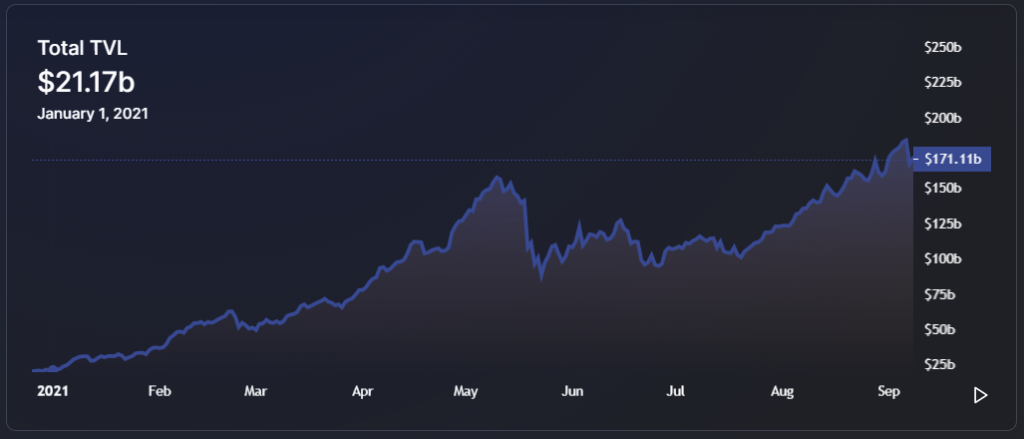The pace of innovation within the decentralized finance (DeFi) world is staggering, with numerous applications and use cases that are redefining the concept of finance as we know it.
This is evident in the exponential growth of the DeFi market, expanding by a staggering rate of 700% since the start of 2021!

In essence, DeFi is an alternative financial system that is predicated on the principles of decentralization, transparency and censorship-resistance, the traits which are native to blockchain technology.
Not only does DeFi offers similar products and services just like those that can be found in the conventional financial system, the evolution of blockchain technology allows new products to be created without the need of a central intermediary.
This opens the door to a new economy that is rich with novel products and systems that can only be found in an on-chain setting of DeFi.
One of the innovative DeFi protocols out there is the system of a no-loss (lossless) lottery, which allows participants to purchase tickets and stand a chance to win rewards. The catch is, their initial capital would never be lost and they can continue to participate in future lottery draws!
Understanding the lottery business
Traditional lotteries have been in existence for a long time, with ancient civilizations delving into various forms of lottery that has evolved into what we see today.
Modern lottery can be classified as a form of gambling, where the majority of participants in the lottery pool contribute their capital and only a selected winner wins the entire pool while the rest loses their initial capital.
Recent innovations within the conventional finance system such as Premium Lottery Bonds and Prize-Linked Savings accounts (also called “lottery-linked deposit account”) are trying to incentivize savings behaviour where a portion of generated interests are distributed to random winners.
The most recent innovation in lottery is in the DeFi space, which is pioneered by PoolTogether back in Septmber 2019 and backed by MakerDAO Foundation and other notable entities like ConsenSys Lab.
Built on the Ethereum blockchain, PoolTogether was the first no-loss lottery protocol in DeFi. Initially launched with two stablecoin pools of DAI and USDC, PoolTogether now has 13 pools with a cumulative TVL of $148 million.

Other no-loss protocol include Yieldly, which is based on Algorand blockchain, and Moonpot, which is based on Binance Smart Chain.
How does no-loss lottery in DeFi work
No-loss lottery is a gamified savings account that incorporates the concept of traditional lottery systems with cryptocurrency staking, with participants forgoing a portion of generated yields to pursue a chance of a potential jackpot. Here is a visual overview of how no-loss lottery works:

As the name suggest, no-loss lottery means that users’ deposits are never lost. Interested users would need to stake their coins in the lottery pool to earn a lottery ticket.
The pooled funds from all participants of the lottery will then be deployed on other DeFi protocols that generate yields like Compound Protocol and Aave, earning interests on the pooled funds.
At the time of the lottery draw, which usually occurs at a weekly time cadence, the protocol would randomly pick out the winning ticket, and all the earned interest be distributed to the winner. Participants initial deposit would be left untouched, and can be withdrawn anytime or recycled to the next draw.
Depending on the protocol, there could also be more than one winner in a pool; PoolTogether has categories for the ‘Grand Prize’ as well as ‘Runner-Up’ prices which will get a smaller share of the rewards.
The majority of participants that were not selected as winners will still earn the native token rewards just by staking their funds on the protocol. This means that not only is the lottery no-loss, but the value of capital for each participant will continually increase because they are rewarded with native tokens.
On average, the annual percentage rate (APR) is around 5% – 24%. This is why no-loss lottery protocols also operate as a savings account, since they provide a healthy yield to participants.
To date, PoolTogether's V3 has garnered over 6,000 continuous lottery players, making it one of the most utilized protocols excluding DEXs pic.twitter.com/KLK2K63pRl
— Messari (@MessariCrypto) March 23, 2021
An interesting component of the no-loss structure is the generation of the random outcome in the selection of the winning ticket.
Due to its decentralized nature, the protocols would need to depend on an oracle, such as Chainlink’s Verifiable Randomness Function (VRF), to ensure that the random outcome generation happens in a decentralized, fair and secure way, which can be proved in an on-chain manner.
How to get started with no-loss lottery
As with all other DeFi applications, no-loss lotteries are non-custodial in nature and all you need to start is your own digital asset wallet. Here are the ways for you to get started:
- Determine your preferred blockchain network. There are no-loss lotteries in different blockchain networks; the most popular no-loss lottery is PoolTogether on the Ethereum blockchain. There’s also Yieldly on Algorand as well as Moonpot if you prefer Binance Smart Chain.
- Connect your digital asset wallet with the protocol. The most common digital asset wallet to store cryptocurrencies is Metamask.
- Select the pool of your choice and deposit the cryptocurrency into the pool. You can choose the pool based on the prize value or if you prefer to stake in a particular asset.
- Once you have deposited your funds into the pool, you will receive tokenized tickets that signifies your entry into the lottery.
- Depending on the protocol, there might be early withdrawal fees if you withdraw your staked funds within a certain time period.
No-loss lotteries are a great example of the rapid innovation of products that have generated widespread interest in DeFi.
More importantly, no-loss lottery represents a paradigm shift in finance, where financial incentives of stakeholders are aligned in a decentralized way and participants are in a win-win situation; winning the lottery confers great financial rewards, and not winning the lottery is also beneficial since they are rewarded with native tokens just by way of staking their funds.
Featured Image Credit: Pixabay
Read also: Here’s How You Can Buy Tokens On Decentralized Exchanges Such As Uniswap



































